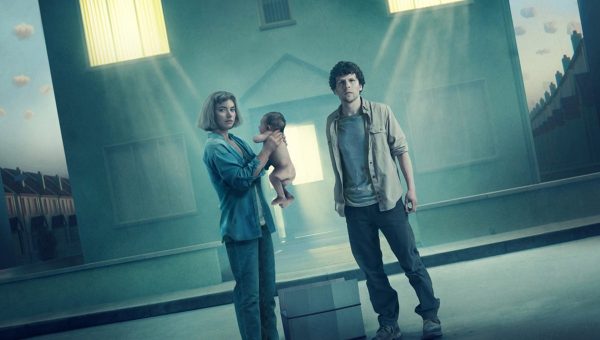Film Review: “Vivarium” — Sheltering in Place
By Peg Aloi
Vivarium offers such a completely well-thought-out narrative that it hardly matters whether we are dealing with magic realism or a satirical fable.
Vivarium, directed by Lorcan Finnegan. Streaming on YouTube, Amazon Prime, Google Play, and Vudu.

Jesse Eisenberg and Imogen Poots in Vivarium.
We’re looking at many things differently these days. Speculative fiction films made prior to the 2020 pandemic seem, in these unprecedented times, to have been strangely clairvoyant. Vivarium — the title means “terrarium — is a Belgian-Irish co-production directed by Lorcan Finnegan, who co-wrote with Garret Shanley. It is an intensely disturbing film filled with with subtle horror and biting social commentary. At its heart are two stellar actors: Jesse Eisenberg (who shines in weird dystopian films like Zombieland and The Double) and Imogen Poots (seen recently with Eisenberg in The Art of Self Defense). Set in an England of the very near future, or perhaps yesterday, the story is unnervingly relevant for those of us currently contemplating what we mean when we say “home.”
The opening scene looks like an artful nature documentary. We see a mother bird feeding its young and a graphic close up that shows nurturing and brutality. Then we see Gemma (Poots), a schoolteacher who is saying goodbye to her students as they run out of the classroom. She then chats with a fellow teacher about the crowded real estate market. The colleague urges her to buy soon; Gemma smiles and nods, hovering somewhere between agreement and ambivalence. Gemma is then called on to comfort a little girl who sees two dead baby birds on the ground, fallen from their nest. “That’s the way things are, it’s nature,” she says, and the child replies, “I hate the way things are.” Sitting up in the tree, Gemma’s boyfriend Tom (Eisenberg) playfully chirps. He’s a landscaper and nature lover; he gently buries the birds. The pair are playful and affectionate with each other as they climb into Gemma’s car.
They arrive at a real estate office that hosts a billboard of a new housing development called “Yonder,” all smiling faces and a creepy slogan. The film shifts visual tone here from realism to a bizarre yet nuanced stylization. Inside the office are framed wall photos of pale, mint-colored houses in rows. The sales agent, Martin (Sherlock’s Jonathan Aris), greets them; he looks odd. His clothes and grooming are doll-like, and he behaves strangely, despite being polite. Tom and Gemma can hardly keep from laughing at Martin’s unusual manner.
Martin tells them that properties are being snapped up, and convinces them to take a tour. They follow him in his van, and arrive at an enormous subdivision full of identical pastel green houses, all of them empty. After a cursory look at the cookie-cutter home and its bland beige furnishings, Tom and Gemma decide they’re not interested. Then they notice that Martin has vanished. They try to leave but, despite driving about for hours, they can’t find their way out of the maze of houses. They decide to spend the night in the house, #9. The next day, trying again to leave, their car runs out of gas. They try the following day to find their way out on foot, following the sun in a bright blue sky, but with no luck, and they keep ending up in front of #9.
The next day a box of food and supplies arrives in front of the house. The victuals are wrapped in plastic and apparently tasteless. Several days later, another box arrives — with a squirming baby boy inside. Tom and Gemma accept that they are trapped, and gradually become resigned to a forced domestic life they didn’t choose. Cryptic messages hint that, if they play along, they will be released — assuming they perform as expected. It’s a bit like one of those old episodes of The Twilight Zone in which people learn they’re subjects in an experiment that is being observed by giants or by scientists. I was also reminded of my favorite episode of Black Mirror, “Hang the DJ,” in which two people using a dating app are put into manipulative situations. Eisenberg and Poots are both excellent as a couple in love who is suddenly forced to live as a family in a house they hate, and with no other purpose in life but to raise a child they don’t know. The metaphorical implications are stunning, and the film engages them in ways both subtle and grandiose.
I wasn’t bothered by the lack of an explanation for the setup, something that normally bothers me in contemporary horror films. I ended up being captivated by every aspect of this film: the perverse yet engaging story arc, the innovative production design, and the cast’s stunning performances. Vivarium offers such a completely well-thought-out narrative that it hardly matters whether we are dealing with magic realism or a satirical fable. The best art creates its own world, drawing on ordinary reality to lull us in, and this is a haunting, and horrifying, take on the first-world suburban lifestyle.
Peg Aloi is a former film critic for the Boston Phoenix and member of the Boston Society of Film Critics. She taught film studies in Boston for over a decade. She writes on film, TV, and culture for web publications like Vice, Polygon, Bustle, Mic, Orlando Weekly, Crooked Marquee, and Bloody Disgusting. Her blog “The Witching Hour” can be found at themediawitch.com.
